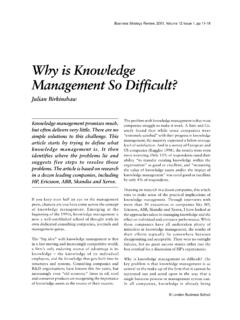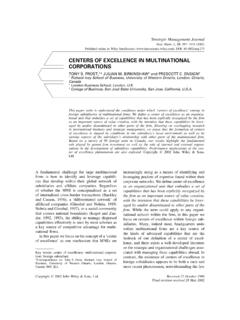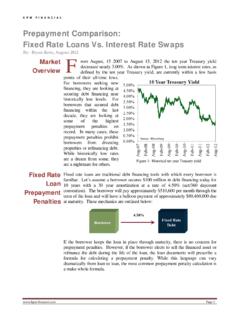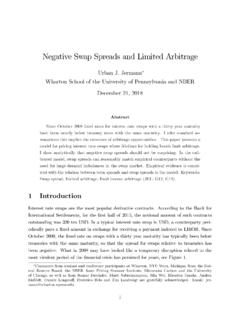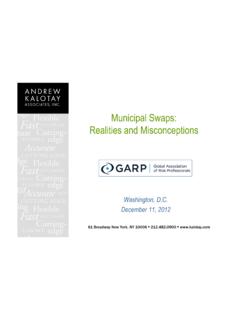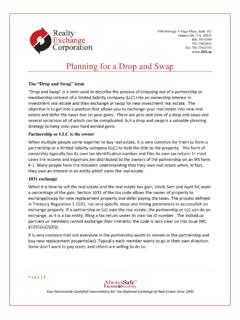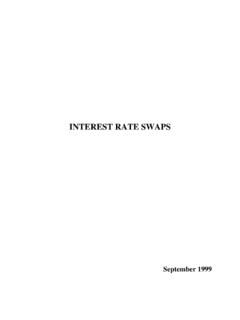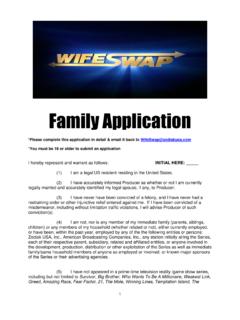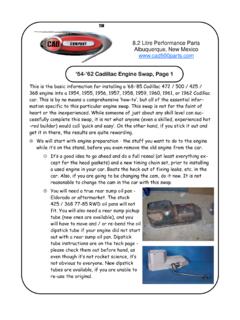Transcription of The Default Risk of Swaps - London Business School
1 THE JOURNAL OF FINANCE VOL. XLVI, NO. 2 JUNE 1991 The Default Risk of SwapsIAN A. COOPER and ANTONIO S. MELLO*ABSTRACTWe characterize the exchange of financial claims from risky Swaps . These transfersare among three groups: shareholders, debtholders, and the swap this analysis we derive equilibrium swap rates and relate them to debtmarket spreads. We then show that equilibrium Swaps in perfect markets transferwealth from shareholders to debtholders. In a simplified case, we obtain closed-formsolutions for the value of the Default risk in the swap. For interest-rate Swaps , weobtain numerical solutions for the equilibrium swap rate, including Default compare these with equilibrium debt market Default risk HAVE BEEN ONE of the most explosive and important innovations ininternational capital markets in the last 10 years. In its simplest form, aswap consists of an agreement hetween two entities (called counterparties) toexchange in the future two streams of cash flows.
2 In a currency swap, thesestreams of cash flows consist of a stream of interest and principal paymentsin one cvtrrency exchanged for a stream, of interest and principal payments ofthe same maturity in another currency. In an interest rate swap they consistof streams of interest payments of one type (fixed or floating) exchanged forstreams of interest payments of the other type in the same currency. The twotypes of swap are shown in Appendix 1.^The economic importance of swap transactions is the fact that they can hecomhined with deht issues to change the nature of the liahility for theborrower. The sum of a hond issue and a currency swap gives a net liabilitystream which is equivalent to transforming the bond liability into a differentcurrency. A floating rate note combined with an interest rate swap results ina liability equivalent to fixed rate issues have dominated the academic literature on Swaps .
3 The firstconcerns the reasons for their use. Arbitrage of imperfections in capitalmarkets was the original cause of their appearance (Price and Henderson(1984)). Turnbull (1987) shows that lowering borrowing costs by a synthetictransaction involving a swap is not possible in a complete, integrated capitalmarket. Subsequent authors (Wall and Pringle (1988); Arak, Estrella,Groodman, and Silver (1988); Smith, Smithson, and Wakeman (1987)) observe*Cooper is Associate Professor of Finance at the London Business School . Mello is AssistantProfessor of Finance at MIT. We are grateful to participants at workshops at Bristol University,Cambridge University, HEC, London Business School , LSE, MIT, and Warwick University forcomments. We are especially grateful to Dick Brealey, Bernard Dumas, Michael Selby, ReneStulz, and two anonymous referees for suggestions.'For an excellent summary of Swaps see Wall and Pringle (1988).
4 597598 The Journal of Financethat market incompleteness or agency costs may provide an alternativeexplanation for the continued growth of the swap second part of the literature on Swaps concerns pricing and hedging,including the pricing of Default risk. Bicksler and Chen (1986) analyze thevaluation of Default -free interest-rate Swaps and demonstrate that the swapis equivalent to holding one type of bond (fixed or floating) financed byselling short the other type. Several papers (Arak, Goodman, and Rones(1986); Federal Reserve Board and Bank of England (1987); Belton (1987))estimate the maximum probable loss on Swaps but do not attempt to valuethe Default risk using an equilibrium model. Whittaker (1987) values thecredit exposure of interest rate Swaps using option pricing but does notendogenize the event triggering the swap Default .
5 His results are, therefore,the value of swap Default assuming that the probability of the event trigger-ing Default is independent of the size of the Default . Sundaresan (1989)models the Default risk premium as a function of an "instantaneous defaultpremium" that follows an exogenous stochastic process. This gives an equi-librium structure of Default premia across different Swaps but does notdetermine the level of the purpose of this paper is to develop a partial equilibrium model forswap Default that: a) is consistent with equilibrium rates for risky debt andenables the comparison of swap Default risk with debt market Default risk; b)makes clear the wealth transfers between corporate claim holders, if any,arising from Swaps ; and c) is applicable to both interest rate Swaps andcurrency Swaps . This analysis is important for at least three types of capitalmarket participants.
6 Banks holding portfolios of Swaps need to be able tomeasure the value of these transactions net of Default risk. Bank regulatorsrequire a consistent way of measuring the potential Default risk so that theycan set appropriate capital requirements. Corporations borrowing and usingswaps to transform their liabilities should include an allowance for defaultrisk in their comparison of the cost of direct and synthetic paper is organized as follows: Section I discusses swap risk. Section IIanalyzes a simplified single-period swap to highlight the wealth transferstaking place. Section III discusses alternative treatments in Default . SectionIV analyzes a swap using a contingent claims analysis similar to the Merton(1974) model of risky debt to enable comparison of swap market spreads withdebt market spreads. Section V applies the model to interest-rate VI contains the concluding Swap RiskThere are two types of risk in swap transactions: rate risk, and Default risk arises because, during the life of the swap, exchange rates andinterest rates vary so that the Default -free present value of the cash flowsremaining to be paid and received through the swap also varies.
7 This raterisk can be hedged by taking offsetting positions in some combination ofcurrency futures, bond and interest rate futures, currency forward contracts,and spot currency and bond Default risks of Swaps 599 The second type of swap risk, Default risk, is much more difficult to risk, sometimes called replacement risk, is complex to evaluate becausethe cost of Default by the counterparty to a swap depends upon four things:the value of the swap at the Default date, the event that will trigger the swapdefault, the relationship between the value of the swap and the eventtriggering Default , and the rule for sharing claims in Default . In swapdefaults there is the added complication that the counterparty that is indefault on its original debt could be due either to make or to receive a swappayment. If it is due to make a payment it will, presumably, Default on theswap contract as well as on the debt if the swap payment is subordinated tothe debt.
8 Alternatively, it could be due to receive a swap payment, in whichcase the swap payment could be received (increasing the value of the bankruptfirm) or the treatment of Swaps in Default is not yet certain, the consen-sus appears to be consistent with the following assumption (Henderson andCates (1986)):Al: Swaps are subordinate to debt in bankruptcy. In the event of a defaulton its debt by a counterparty that is owed value in a swap, the value ofthe swap will be paid to the bankrupt firm. The swap contract will betreated as a contract for the net cash fiows due in the swap, not as anexchange of gross assumption is used throughout this paper except where it is explicitlystated otherwise. We assume that no collateral is held by the counterpartyexposed to Default risk. The assumption that the Swaps are not coUateralizedis important in comparing the sizes of the swap spreads and the debt marketspreads.
9 ^ In the limit, coUateralization could reduce the equilibrium swapspread to zero. Our analysis could be extended to include collateral, but suchan extension is beyond the scope of this Analysis of Default Risk: Distribution-FreeResults for Single-Period SwapsIn this section we analyze the impact of settlement rules on the Default riskof the swap and on wealth arising from the swap. Since we are interested inthe simplest possible swap that will highlight the economic substance of theanalysis, we focus on single-period Swaps . At this stage, we make no distinc-tion between interest-rate Swaps and currency Swaps because the qualitativesubstance of the results is not different for the two types. The stylizedsingle-period setting that we analyze is characterized by the followingassumptions:A2: Capital markets are perfect and competitive. There are no deadweightcosts to bankruptcy.^In the recent Default by a Local Authority in England, collateralization did not seem to beimportant.
10 By some estimates, bank counterparties in the swap contracts stand to lose siround The Journal of FinanceA3: There is one risky counterparty, called firm 1. It has real assets withcurrent value VQ. At maturity date of the debt T, the random value ofthe firm will be V^.A4: It has raised funds of amount B in a 'variable' debt market by issuinga zero coupon variable bond with face value Xj. and maturity T. Theremainder of the firm is financed with equity. Equity pays no divi-dends prior to the debt matiu" : There is a swap counterparty Z which is riskless. Firm 1 can contractwith Z a swap which pays at time T the amount (F - Xj<) from firm 1to Z. If (F - Xj-) is negative, the amount (Xj^ - F) is paid at T fromZ to firm 1.^Debt in this case is zero coupon, and 'variable' debt involves a promise topay, at the debt maturity date T, an amount which is equal to the realizationof a random variable Xj^.
